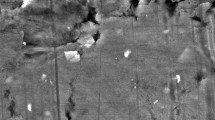Abstract
Aluminum and copper are widely used for microelectronic interconnect applications. Interfacial oxides can cause device performance degradation and failure by significantly increasing electrical resistance. Interfacial oxide layers found in Al/Ta and Ta/Cu metal stacks were studied using Transmission Electron Microscopy (TEM) combined with Energy Dispersive Spectroscopy (EDS) and Parallel Electron Energy Loss Spectroscopy (PEELS). The analysis indicates that the observed interfacial oxide layers, Al2O3 and mainly Ta2O5, result from spontaneous reductions of Ta oxide and Cu oxide, respectively. Thermodynamics enables interpretation of the results.
Similar content being viewed by others
References
C. R. M. Grovenor, Microelectronic Materials (IOP Publishing, Philadelphia, PA, 1989) p. 239.
S. P. Murarka, M. C. Peckerar, Electronic Materials: Science and Technology (Academic Press, San Diego, CA, 1989) p. 284.
L. M. Koschier, S. R. Wenham, in Record of the Twenty-Eighth IEEE Photovoltaic Specialists Conference – 2000 (IEEE - Piscataway, NJ, USA, 2000), p. 407.
M. A. Taubenblatt and C.R. Helms, J. Appl. Phys. 53(9) 6308(1982).
M. Liehr, F. K. LeGoues, G. W. Rubloff, P. S. Ho, J. Vac. Sci. Technol. A 3 (3) 983 (1985).
T. Ohwaki, K. Aoki, T. Yoshida, S. Hashimoto, Y. Mitsushima, Y. Taha, Surface Science, 496, 433 (1999).
Ch. Laurent, Ch. Blaszczyk, M. Brieu, A. Rousset, Nanostructured Materials 6 317(1995).
Yu. V. Naidich, Prog. Surf. Membrane Sci., 14, 353 (1981).
D. M. Lipkin, J. N. Israelachvili, and D. R. Clarke, Philosophical Magazine A, 76, 715 (1997).
U. Diebold, J-M Pan, and T. E. Madey, Surf. Sci., 333, 845 (1995).
A. A. Volinsky, “A Comparison Study of Ti/GaAs Ti/Si Fracture, Mechanics of Thin Films and Other Small Structures Symposium”, presented at the 14th U.S. National Congress of Theoretical and Applied Mechanics, Blacksburg, Virginia, (2002) (unplublished).
G. Cliff, and G. Lorimore, Journal of Microscopy, 103 203 (1975).
D. Joy in Principles of Analytical Electron Microscopy, edited by D. Joy, A. Romig, Jr., and J. Goldstein (Plenum Press, New York and London, 1986), p. 155.
B. Vincent Crist in Monochromatic XPS Spectra: The Elements and Native Oxides, (Wiley, Chichester, England, 2000) p. 478.
Himpsel, et al., Phys. Rev. B, 30 (12), 7236 (1984).
N. N. Greenwood & A. Earnshaw in Chemistry of the Elements (Butterworth-Heinemann, Oxford, 1997), p. 981.
L. F. Epstein in Ceramic Age, (April 1954) 37.
R. Egerton in Electron Energy-Loss Spectroscopy in the Electron Microscope (Plenum Press, New York and London, 1996), p. 280.
C. Ahn and O. Krinavek, in EELS Atlas (1983).
Author information
Authors and Affiliations
Rights and permissions
About this article
Cite this article
Qin, W., Volinsky, A.A., Werho, D. et al. Oxide Reduction in Advanced Metal Stacks for Microelectronic Applications. MRS Online Proceedings Library 786, 633 (2003). https://doi.org/10.1557/PROC-786-E6.33
Published:
DOI: https://doi.org/10.1557/PROC-786-E6.33




